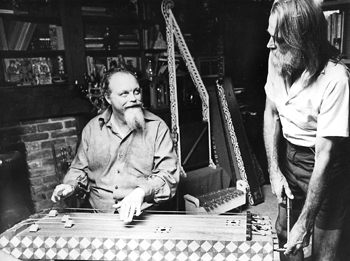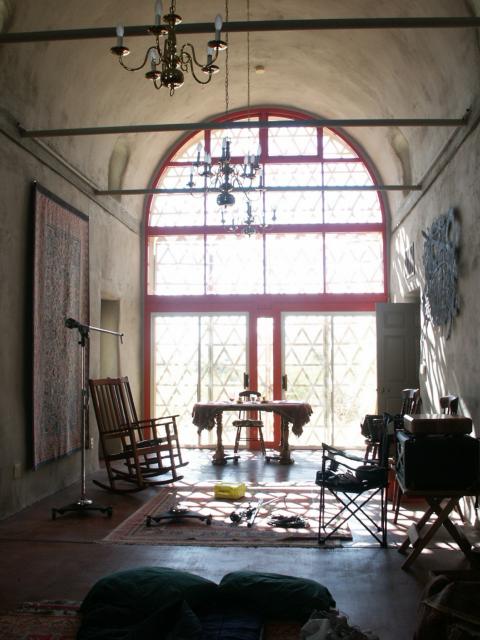
Lou Harrison (left) and Bill Colvig in the 1970s with a monochord (although this one has more than one string), an ancient instrument designed to be used as a tuning standard. This modern version was constructed by Colvig. |
 In 1949, the composer-critic Virgil Thomson gave Lou Harrison a curious book with the instruction, "Here Lou, see what you can make of this." The book, Genesis of a Music by the eccentric visionary composer Harry Partch, would be a revelation for Harrison, who saw in it that the roots of his own compositional crisis of that period lay in the acoustics of musical sounds themselves. To Harrison, like nearly all other musicians even today, the details of why the Western world arrived at a particular tuning system, known as twelve-tone equal temperment and now represented with industrial efficiency on every living room piano, seemed arcane and irrelevant. However, once he went out and bought a tuning hammer and heard the sounds Partch was writing about for himself, Harrison's ears were opened and, in his words, he never looked back. The Mode CD Por Gitaro accurately represents the technicolor world of Harrison's intended tunings with the technology of refretted guitars. In 1949, the composer-critic Virgil Thomson gave Lou Harrison a curious book with the instruction, "Here Lou, see what you can make of this." The book, Genesis of a Music by the eccentric visionary composer Harry Partch, would be a revelation for Harrison, who saw in it that the roots of his own compositional crisis of that period lay in the acoustics of musical sounds themselves. To Harrison, like nearly all other musicians even today, the details of why the Western world arrived at a particular tuning system, known as twelve-tone equal temperment and now represented with industrial efficiency on every living room piano, seemed arcane and irrelevant. However, once he went out and bought a tuning hammer and heard the sounds Partch was writing about for himself, Harrison's ears were opened and, in his words, he never looked back. The Mode CD Por Gitaro accurately represents the technicolor world of Harrison's intended tunings with the technology of refretted guitars.
|
 |
The frets on most guitars are straight, conforming to the twelve-tone equal temperament standard. In order to realize these works in other tunings, John Schneider used several guitars in this recording. Among them is an instrument built by luthier Walter Vogt which uses his Fret-Mobile system (pictured at left). On this instrument, the frets can be individually adjusted under each string by means of a track along which they slide. The configuration shown here is for the recording of In Honor of the Divine Mr. Handel. On other tracks, Schneider used "Switchboards," a system invented by Tom Stone that first inspired Harrison to write for just intonation guitars in the 1970s. In this system, a fingerboard can be easily removed and replaced with another, so that a new tuning can be effected by simply building a fingerboard with new frets, rather than a whole new guitar. Pictured below is Schneider's Switchboard guitar together with the various fingerboards he has constructed for it.

While those wanting to learn more about the details of tuning theory can find a very accessible introduction here, here is some brief background necessary to understand the following figures. The frequency of a tone is defined by the number of sound waves per second (Hertz or hz), but the interval between two notes is not defined by the difference between the two numbers, but rather their ratio. In other words, as we move linearly up the piano keyboard, the frequency goes up at a geometric rate, doubling every octave (easily visible on a guitar neck as the frets crowd together when they approach the bridge). When this ratio is reducible to a pair of relatively small integers (2/1 in the case of the octave), the interval is said to be "just" and a tuning system based on it "just intonation."
Why then would Harrison declare that, "The best intonation is just intonation"? When the notes of string and wind instruments are related by just intervals, their harmonics ("overtones") line up, reinforcing each other smoothly and with crystalline clarity. On the other hand, when the frequencies are compromised or "tempered" in order to allow for such expedients as straight guitar frets, freedom of modulation, and standardization of all instruments, the intervals are no longer just -- their no longer coincident harmonics create beats and dissonance, resulting in a "roughness" in the harmonies. Harrison often spoke critically of the unquestioning allegiance to equal temperament and felt that each tuning scheme had its own advantages and disadvantages which a composer should be able to select from based on his own musical goals.
|
|
Here are details about the tuning for each of the works on Por Gitaro:
John Schneider recorded these works in Lou Harrison's "last great composition": his straw bale house in Joshua Tree, California. The architecture of the house, designed by Harrison himself, is based on the same Pythagorean ratios as in the Ditone Set. The stucco-lined grand hall, with its (for this type of construction) unique vaulted ceiling gives an acoustical warmth to the recording. At right is a photo of the hall the morning after a recording session.
For further reading:
- John Schneider. "Just Lou Harrison," Guitar Review #128, (2004): 13-23.
- John Schneider. "Just Guitar," Guitar International #6 (April/June 2004): 42-50.
- John Schneider. "Lou Harrison's Guitars," Classical Guitar [UK] 21 #10 (June 2003): 20-23.
|  |

 In 1949, the composer-critic Virgil Thomson gave Lou Harrison a curious book with the instruction, "Here Lou, see what you can make of this." The book, Genesis of a Music by the eccentric visionary composer Harry Partch, would be a revelation for Harrison, who saw in it that the roots of his own compositional crisis of that period lay in the acoustics of musical sounds themselves. To Harrison, like nearly all other musicians even today, the details of why the Western world arrived at a particular tuning system, known as twelve-tone equal temperment and now represented with industrial efficiency on every living room piano, seemed arcane and irrelevant. However, once he went out and bought a tuning hammer and heard the sounds Partch was writing about for himself, Harrison's ears were opened and, in his words, he never looked back. The Mode CD Por Gitaro accurately represents the technicolor world of Harrison's intended tunings with the technology of refretted guitars.
In 1949, the composer-critic Virgil Thomson gave Lou Harrison a curious book with the instruction, "Here Lou, see what you can make of this." The book, Genesis of a Music by the eccentric visionary composer Harry Partch, would be a revelation for Harrison, who saw in it that the roots of his own compositional crisis of that period lay in the acoustics of musical sounds themselves. To Harrison, like nearly all other musicians even today, the details of why the Western world arrived at a particular tuning system, known as twelve-tone equal temperment and now represented with industrial efficiency on every living room piano, seemed arcane and irrelevant. However, once he went out and bought a tuning hammer and heard the sounds Partch was writing about for himself, Harrison's ears were opened and, in his words, he never looked back. The Mode CD Por Gitaro accurately represents the technicolor world of Harrison's intended tunings with the technology of refretted guitars.


